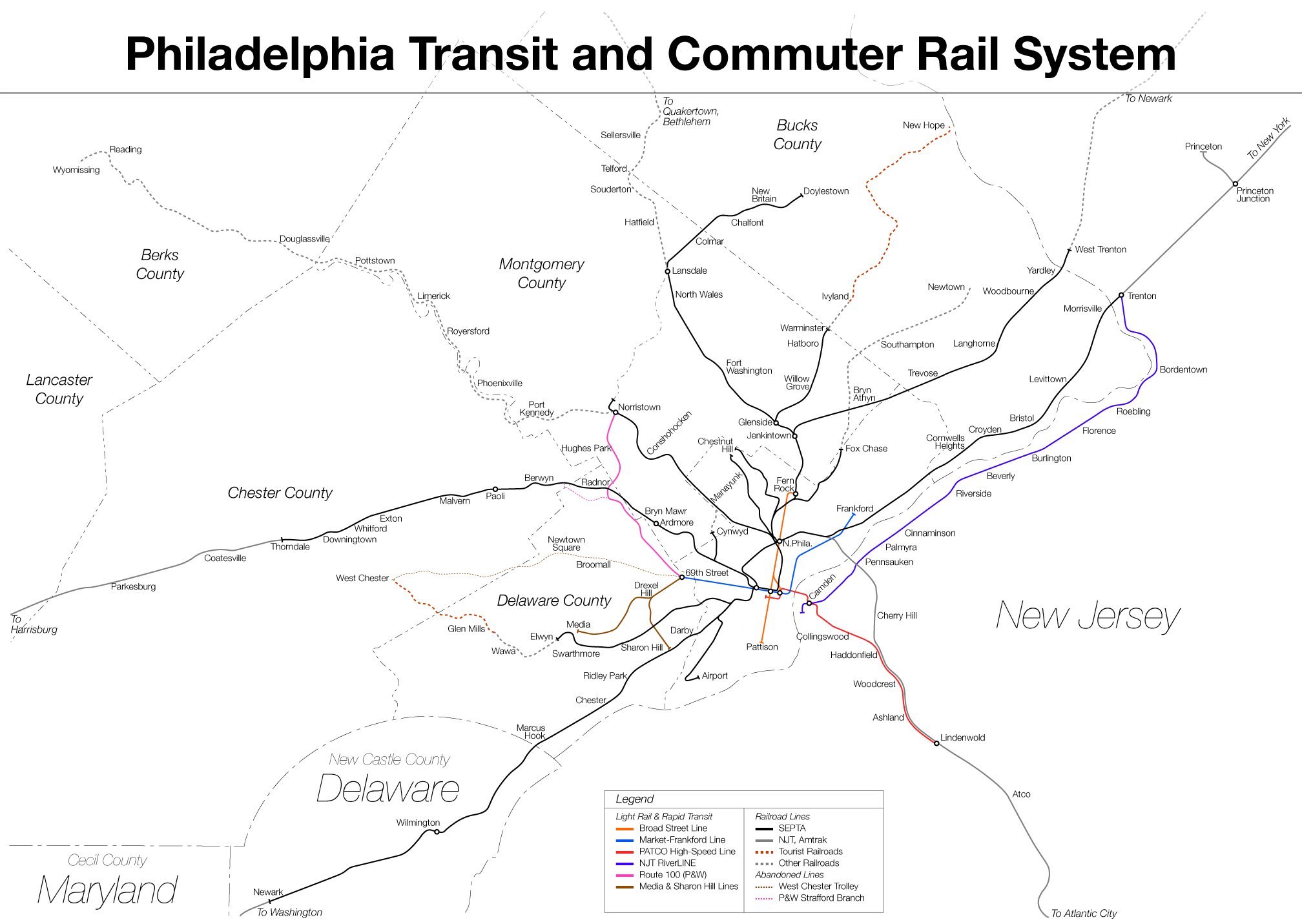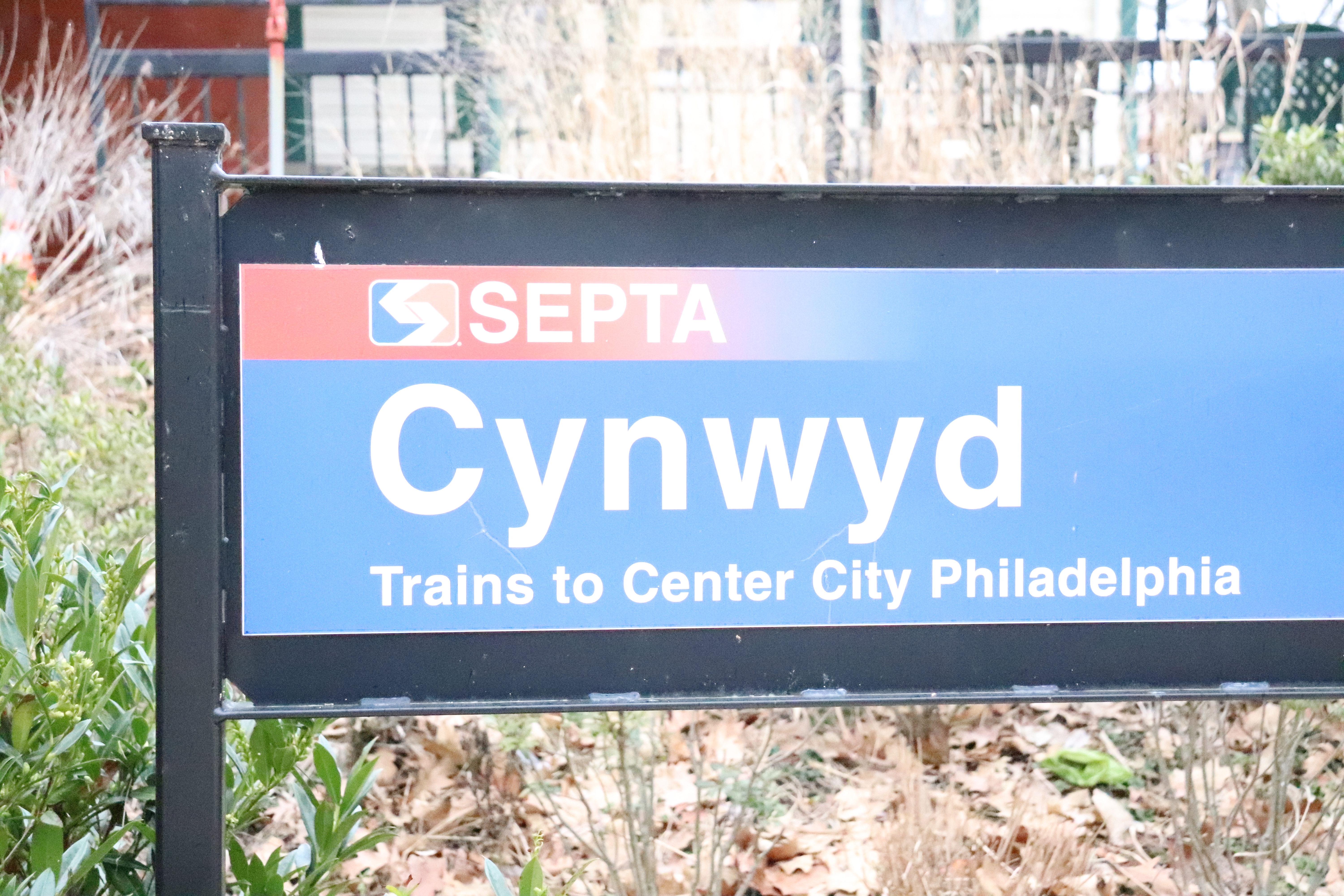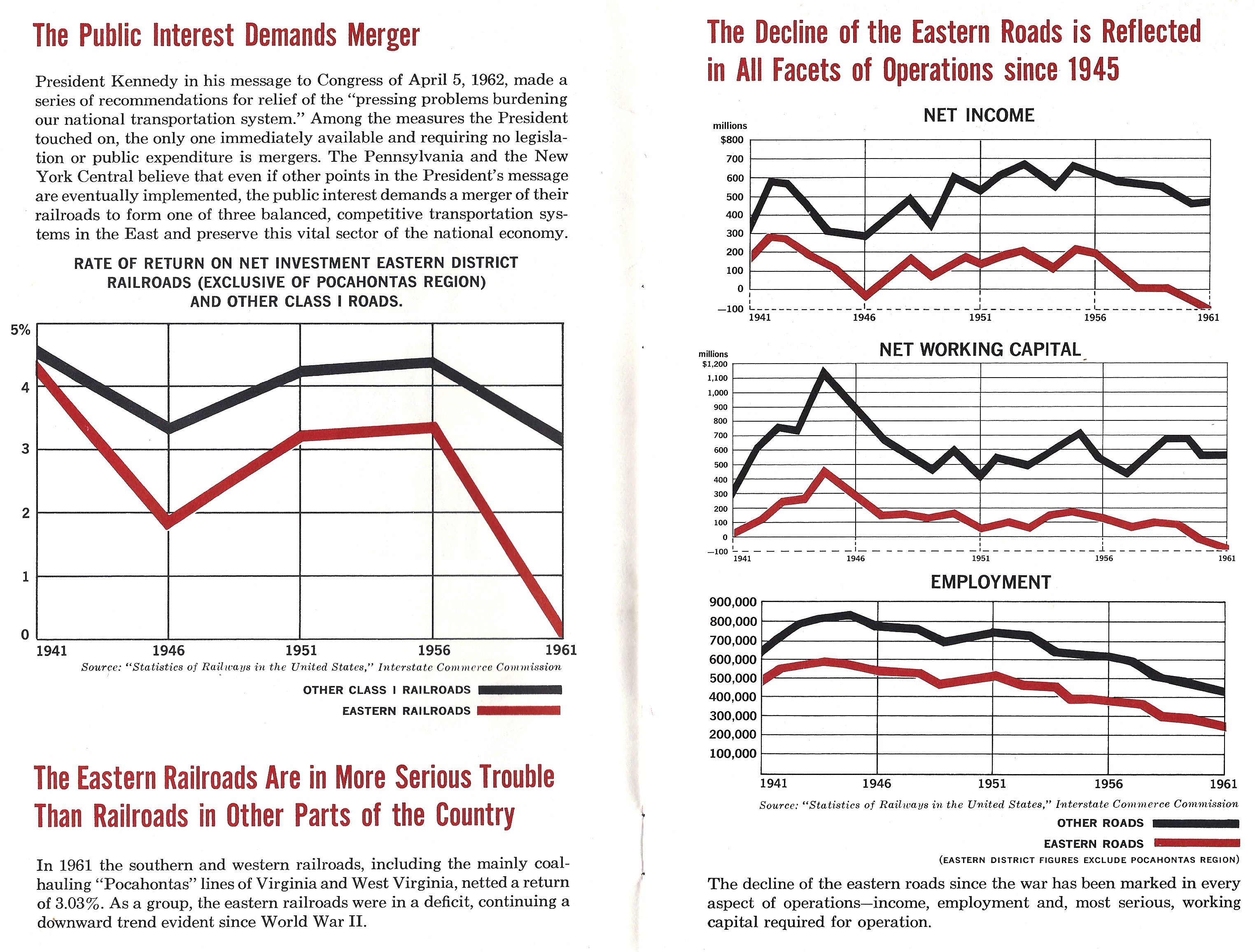|
SEPTA Diesel Service
The SEPTA Regional Rail system is a commuter rail network owned by the Southeastern Pennsylvania Transportation Authority and serving the Philadelphia Metropolitan area. The system has 13 branches and more than 150 active stations in Philadelphia, Pennsylvania, its suburbs and satellite towns and cities. It is the fifth-busiest commuter railroad in the United States, and the busiest outside of the New York and Chicago metropolitan areas. In 2016, the Regional Rail system had an average of 132,000 daily riders and 118,800 daily riders (As of 2019). The core of the Regional Rail system is the Center City Commuter Connection, a tunnel linking three Center City stations: the above-ground upper level of 30th Street Station, the underground Suburban Station, and Jefferson Station (formerly Market East Station). All trains stop at these Center City stations; most also stop at Temple University station on the campus of Temple University in North Philadelphia. Operations are handle ... [...More Info...] [...Related Items...] OR: [Wikipedia] [Google] [Baidu] |
SEPTA
The Southeastern Pennsylvania Transportation Authority (SEPTA) is a regional public transportation authority that operates bus, rapid transit, commuter rail, light rail, and electric trolleybus services for nearly 4 million people in five counties in and around Philadelphia, Pennsylvania. It also manages projects that maintain, replace and expand its infrastructure, facilities and vehicles. SEPTA is the major transit provider for Philadelphia and the counties of Delaware, Montgomery, Bucks, and Chester. It is a state-created authority, with the majority of its board appointed by the five Pennsylvania counties it serves. While several SEPTA commuter rail lines terminate in the nearby states of Delaware and New Jersey, additional service to Philadelphia from those states is provided by other agencies: the PATCO Speedline from Camden County, New Jersey is run by the Delaware River Port Authority, a bi-state agency; NJ Transit operates many bus lines and a commuter rail line to ... [...More Info...] [...Related Items...] OR: [Wikipedia] [Google] [Baidu] |
Center City Commuter Connection
250px, The ASCE plaque in Jefferson Station 250px, City plaque in Jefferson Station The Center City Commuter Connection, (CCCC) commonly referred to as "the commuter tunnel", is a passenger railroad tunnel in Center City, Philadelphia, Pennsylvania, United States, built to connect the stub ends of the two separate regional commuter rail systems, originally operated by two rival railroad companies: the Pennsylvania Railroad and the Reading Company. All of the SEPTA Regional Rail lines except for the Cynwyd Line pass completely through the four-track tunnel, which contains two underground stations, Suburban Station and Jefferson Station, and the above-ground upper-level concourse for the east–west commuter lines serving 30th Street Station. Planning and development Suburban Station, located at 16th Street and JFK Boulevard, was the underground terminus of the commuter rail lines of the Pennsylvania Railroad (PRR). The Reading Company (RDG) ran trains on an elevated approach ... [...More Info...] [...Related Items...] OR: [Wikipedia] [Google] [Baidu] |
Chestnut Hill West Line
The Chestnut Hill West Line is a commuter rail line in the SEPTA Regional Rail network. It connects Northwest Philadelphia, including the eponymous neighborhood of Chestnut Hill, as well as West Mount Airy and Germantown, to Center City. Route description The Chestnut Hill West Line branches off from Amtrak's Northeast Corridor at North Philadelphia station and runs entirely within the City of Philadelphia. Its terminal is named Chestnut Hill West to distinguish it from the end of the Chestnut Hill East Line (a competing line of the Reading Company until 1976, when SEPTA assumed operations). Some stations are less than half a mile apart, a characteristic more commonly seen in an urban rapid transit system rather than a commuter rail line. The line runs roughly parallel to the Chestnut Hill East, and the two terminals are rather close. The line is fully grade-separated. History The line was originally opened June 11, 1884 by the Philadelphia, Germantown and Chestnut Hill Rai ... [...More Info...] [...Related Items...] OR: [Wikipedia] [Google] [Baidu] |
Airport Line (SEPTA)
The Airport Line (formerly the R1 Airport) is a route of the SEPTA Regional Rail commuter rail system in Philadelphia, Pennsylvania, which officially runs between Philadelphia International Airport through Center City to Temple University station. In practice, however, only a few trains originate or terminate at Temple; most are through routed with lines to the north after leaving the Center City Commuter Connection. Half of weekday trains are through routed with the Warminster Line, with the other half of weekday trains through routed with the Fox Chase Line. All weekend and holiday trains are through routed with the Warminster Line and terminate either in Warminster or Glenside. The line between Center City and the airport runs seven days a week from 5:00 am to midnight with trains every 30 minutes on weekdays and every hour on weekends and holidays. The trip length from Suburban Station to the airport is 19 to 24 minutes. The line is fully grade-separated in the normal service ... [...More Info...] [...Related Items...] OR: [Wikipedia] [Google] [Baidu] |
Cynwyd Line
The Cynwyd Line is a SEPTA Regional Rail line from Center City, Philadelphia, Center City Philadelphia to Cynwyd (SEPTA station), Cynwyd in Montgomery County, Pennsylvania, Montgomery County, Pennsylvania. Originally known as the Ivy Ridge Line, service was truncated on May 17, 1986, at its current terminus at Cynwyd (SEPTA station), Cynwyd. Track between Cynwyd and Ivy Ridge (SEPTA station), Ivy Ridge was dismantled between 2008 and 2010 for conversion as an interim rail trail, preventing service restoration for the foreseeable future. The Cynwyd Line is the shortest of the SEPTA regional rail lines, and is the second-shortest regional rail line in the United States after New Jersey Transit, New Jersey Transit's Princeton Branch. It is by far the least ridden SEPTA Regional Rail Line. It is fully Grade separation, grade-separated. Route The Cynwyd Line runs from Suburban Station to the 52nd Street Junction, where it diverges from Amtrak's Philadelphia to Harrisburg Main Line, ... [...More Info...] [...Related Items...] OR: [Wikipedia] [Google] [Baidu] |
Reading Terminal
The Reading Terminal ( ) is a complex of buildings that includes the former Reading Company main station located in the Market East section of Center City in Philadelphia, Pennsylvania, United States. It comprises the Reading Terminal Headhouse, Trainshed, and Market. History Construction In 1889, the Philadelphia and Reading Railway decided to build a train depot, passenger station, and company headquarters on the corner of 12th and Market Streets. The move came eight years after the Pennsylvania Railroad opened its Broad Street Station several blocks away at 15th and Market Streets, and one year after the Baltimore and Ohio Railroad opened its 24th Street Station at 24th and Chestnut Streets. The chosen location was occupied by an open-air market that had been in continuous operation since 1853. After loud complaints and much negotiation, the railroad agreed to purchase the markets for $1 million and move them to a new structure: the Reading Terminal Market, located ... [...More Info...] [...Related Items...] OR: [Wikipedia] [Google] [Baidu] |
Reading Company
The Reading Company ( ) was a Philadelphia-headquartered railroad that provided passenger and commercial rail transport in eastern Pennsylvania and neighboring states that operated from 1924 until its 1976 acquisition by Conrail. Commonly called the Reading Railroad, and logotyped as Reading Lines, the Reading Company was a railroad holding company for the majority of its existence and was a single railroad during its later years. It operated service as Reading Railway System and was a successor to the Philadelphia and Reading Railway Company, founded in 1833. Until the decline in anthracite loadings in the Coal Region after World War II, it was one of the most prosperous corporations in the United States. Competition with the modern trucking industry that used the interstate highway system for short-distance transportation of goods, also known as short hauls, compounded the company's problems, forcing it into bankruptcy in 1971. Its railroad operations were merged into Conrail i ... [...More Info...] [...Related Items...] OR: [Wikipedia] [Google] [Baidu] |
Penn Central
The Penn Central Transportation Company, commonly abbreviated to Penn Central, was an American Railroad classes, class I railroad that operated from 1968 to 1976. Penn Central combined three traditional corporate rivals (the Pennsylvania Railroad, Pennsylvania, New York Central Railroad, New York Central and the New York, New Haven and Hartford Railroad, New York, New Haven and Hartford railroads), all united by heavy service into the New York metropolitan area and (to a lesser extent) New England and Chicago. The new company failed barely two years after formation, the largest bankruptcy in U.S. history at the time. The Penn Central's railroad assets were nationalized into Conrail along with the other bankrupt northeastern roads; its real estate and insurance holdings successfully Reorganization, reorganized into American Premier Underwriters. History Pre-merger The Penn Central railroad system developed in response to challenges facing Northeast United States, northeaste ... [...More Info...] [...Related Items...] OR: [Wikipedia] [Google] [Baidu] |
Pennsylvania Railroad
The Pennsylvania Railroad (reporting mark PRR), legal name The Pennsylvania Railroad Company also known as the "Pennsy", was an American Class I railroad that was established in 1846 and headquartered in Philadelphia, Pennsylvania. It was named for the commonwealth in which it was established. By 1882, Pennsylvania Railroad had become the largest railroad (by traffic and revenue), the largest transportation enterprise, and the largest corporation in the world. Its budget was second only to the U.S. government. Over the years, it acquired, merged with, or owned part of at least 800 other rail lines and companies. At the end of 1926, it operated of rail line;This mileage includes companies independently operated. PRR miles of all tracks, which includes first (or main), second, third, fourth, and sidings, totalled 28,040.49 at the end of 1926. in the 1920s, it carried nearly three times the traffic as other railroads of comparable length, such as the Union Pacific and Atchison, T ... [...More Info...] [...Related Items...] OR: [Wikipedia] [Google] [Baidu] |
Temple University
Temple University (Temple or TU) is a public state-related research university in Philadelphia, Pennsylvania. It was founded in 1884 by the Baptist minister Russell Conwell and his congregation Grace Baptist Church of Philadelphia then called Baptist Temple. On May 12, 1888, it was renamed the Temple College of Philadelphia. By 1907, the institution revised its institutional status and was incorporated as a research university. As of 2020, about 37,289 undergraduate, graduate and professional students were enrolled at the university. Temple is among the world's largest providers of professional education (law, medicine, podiatry, pharmacy, dentistry, engineering and architecture), preparing the largest body of professional practitioners in Pennsylvania. History Temple University was founded in 1884 by Grace Baptist Church of Philadelphia and its pastor Russell Conwell, a Yale-educated Boston lawyer, orator, and ordained Baptist minister, who had served in the Union Army d ... [...More Info...] [...Related Items...] OR: [Wikipedia] [Google] [Baidu] |
Temple University (SEPTA Station)
Temple University station is an above-ground SEPTA Regional Rail station located at the eastern edge of the Temple University campus at 915 West Berks Street between 9th and 10th Streets, in the Cecil B. Moore section of Lower North Philadelphia, Pennsylvania. The station is in the Center City fare zone, although the station itself is located in North Philadelphia. There is a small ticket kiosk located at the base of the stairs on the street level. Temple University maintains a security kiosk at street level. Stairways and two elevators lead up to the high-level platforms at track level. There are two island platforms serving four tracks. Each platform is 380 feet (115.824 meters) long, long enough to platform four cars with only the end doors being used. The platforms have a canopy overhead and some wind-breaking walls, but are otherwise exposed to the weather. This station is located approximately 2.6 track miles from Suburban Station. In FY 2005, Temple University stati ... [...More Info...] [...Related Items...] OR: [Wikipedia] [Google] [Baidu] |
Jefferson Station (SEPTA)
Jefferson Station (formerly named Market East Station) is an underground SEPTA Regional Rail station located on Market Street (Philadelphia), Market Street in Philadelphia, Pennsylvania. It is the easternmost of the three Center City, Philadelphia, Center City stations of the SEPTA Regional Rail system, and is part of the Center City Commuter Connection, which connects the former Penn Central commuter lines with the former Reading Company commuter lines. While the station's official SEPTA address is 12th and Filbert streets, it actually spans two city blocks, from 12th to 10th streets just north of Market Street (Philadelphia), Market Street. In 2014, the station saw approximately 26,000 passengers every weekday. History Market East Station was built as part of the $300-million Center City Commuter Connection project, which constructed a tunnel between the former Suburban Station and an existing viaduct near Temple University station and unified commuter rail service in Philadel ... [...More Info...] [...Related Items...] OR: [Wikipedia] [Google] [Baidu] |








